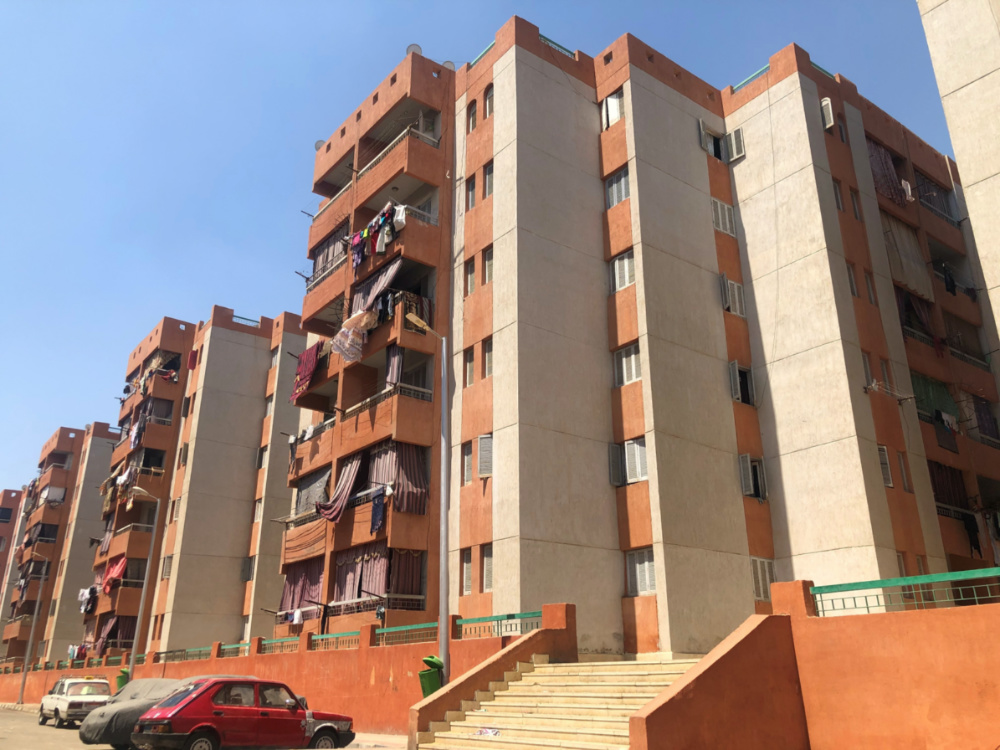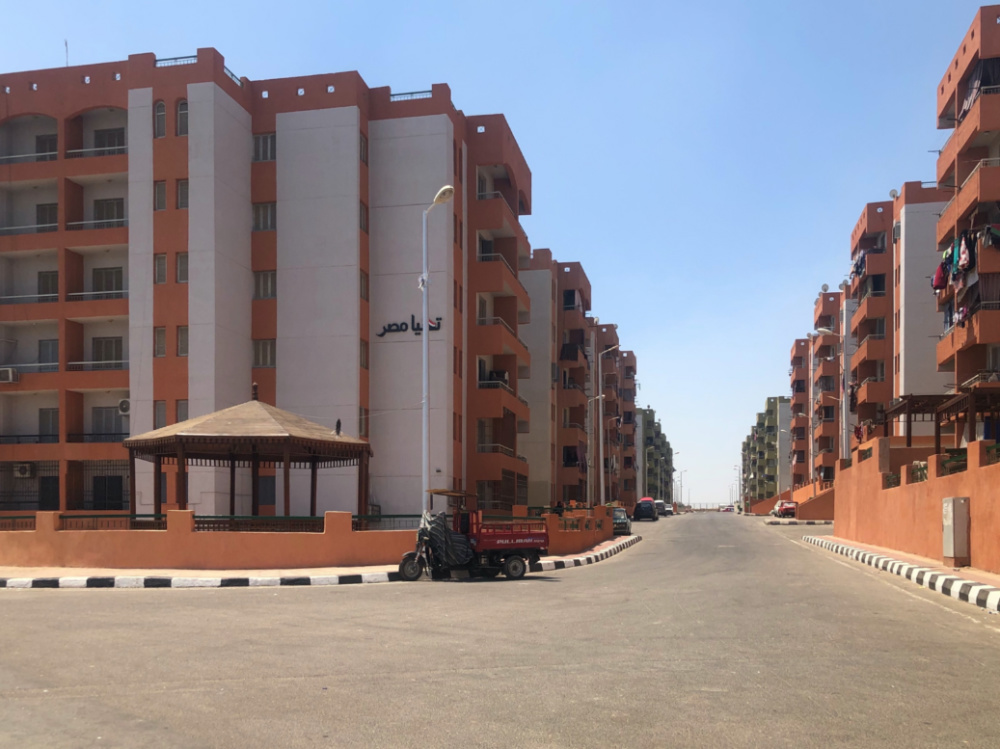
MENNA A FAROUK, writing for the Thomson Reuters Foundation, looks at an initiative to rehouse slum dwellers in new social housing units…
Cairo, Egypt
Thomson Reuters Foundation
In a compound in south-eastern Cairo, Elham Fouad walks through a clean, organised street full of colourful buildings with her husband and young daughter.
The scene in the Mokattam suburb is a far cry from el-Deweika, a sprawling slum in the Egyptian capital, where she used to live in a dilapidated house with her family.
“We were always at risk of landslides and we barely had access to many of the basic services like water and electricity,” 32-year-old Fouad told the Thomson Reuters Foundation from a small grocery store.
“Now, it is a whole different life. We are living like all other humans in a good house with access to all services,” said Fouad, who now lives the el-Asmarat compound in Mokattam.

Housing units in the Mokattam suburb where slum dwellers have been relocated in Cairo, Egypt, on 30th July. PICTURE: Thomson Reuters Foundation/Menna A. Farouk
She is one of about 750,000 slum dwellers who have been relocated in the past four years to social housing units across the country, according to Khaled Sedeek, executive director of the government’s Informal Settlements Development Fund.
About 22 million Egyptians – roughly a quarter of the population – live in slums, including 850,000 people who live in unsafe settlements at risk of landslides and floods, says the ISDF.
“We were always at risk of landslides and we barely had access to many of the basic services like water and electricity. Now, it is a whole different life. We are living like all other humans in a good house with access to all services.”
– Elham Fouad.
Sixty per cent of slum dwellers live in the greater Cairo area, including an estimated 1.5 million in a sprawling cemetery known as the City of the Dead.
But relocated residents point to challenges such as higher overall expenses in the new housing units and an uncertain future for the informal businesses they used to run in slums.
The housing scheme is part of a five-year government project started in 2016 to either demolish or upgrade unsafe slums and relocate some 850,000 people.
It is part of Egypt’s commitment to globally agreed sustainability goals, which include making cities safer and more resilient by 2030.
The new homes are fully-furnished, include household appliances and are let on a symbolic rent between 300 to 350 Egyptian pounds ($US19 to $US22), depending on the standard of the unit.
New compounds include gardens, schools, sports facilities, medical centres, shops, places of worship and access to public transport.
Modernising Cairo is also part of efforts by President Abdel Fattah al-Sisi to attract investment and boost Egypt’s economy still reeling after the Arab Spring upheaval of 2011.
Since taking office in 2014, Sisi has sought to transform the city, building a new administrative capital on its outskirts and aiming to attract investors to its centre.
The Maspero triangle, a slum amid high-end buildings in the heart of Cairo, is being developed into a commercial and entertainment hub, with money generated from land sales providing cash for the government to finance relocation and compensation costs.
The government also demolished about a dozen slums in Egypt’s second-largest city of Alexandria and Port Said, on the Suez Canal, Sedeek said in a phone interview.

Housing units in the Mokattam suburb where slum dwellers have been relocated in Cairo, Egypt, on 30th July. PICTURE: Thomson Reuters Foundation/Menna A. Farouk
But such housing changes come at a cost, some of those who have benefitted from relocation or slum upgrading have found.
Saber Ahmed, 41, said it is a better life for his family, but their expenses have significantly increased since they were relocated from the Ezbet Khairallah neighbourhood near Old Cairo to the el-Asmarat compound.
“We pay rent of 300 Egyptian pounds in addition to electricity, water and household gas bills. For me, it is too much,” said Ahmed, who works as a factory worker.
“It was better living in our house which we owned. We did not have such expenses,” he noted, adding he now needs to take public transport to get to his workplace, an additional cost.
Even though Sisi raised the minimum wage last year to 2,000 Egyptian pounds ($US125) from 1,200 Egyptian pounds, poverty is among the highest in the world, with one in four Egyptians living on less than $US1.65 a day.
While the elite lives in gated communities with blossoming gardens and artificial lakes or in luxury flats overlooking the Nile, the poor set up homes anywhere they can. Many say they have no clean water or sanitation.
Those relocated to social housing compounds also fear they may not be able to keep the informal businesses they used to run in the slums.
About two out of three jobs in Egypt are in the informal sector, according to a study released by the International Labour Organization in 2018.
“The majority of slum dwellers belong to the informal economy and many of them lost their jobs when they were relocated to the new sanitised areas where they are not allowed to do the same,” Atef Amin, head of the Egyptian Coalition for Upgrading Slums, an NGO, said.
Given these challenges, some civil society groups have started to pay visits to the new compounds and offer citizens food and financial assistance.
“The majority of slum dwellers belong to the informal economy and many of them lost their jobs when they were relocated to the new sanitised areas where they are not allowed to do the same.”
– Atef Amin, head of the Egyptian Coalition for Upgrading Slums.
Sedeek said the government had allocated 38 billion Egyptian pounds ($US2.4 billion) to destroy all unsafe areas by the end of the year.
A total of 157,000 out of 240,000 housing units have been built so far to relocate residents from unsafe areas, he added.
Consultations with residents is part of the relocation process, said Sedeek.
“We made surveys with slum dwellers and we adjusted our plans according to their demands. Not all of them were met, but we tried as much as we could to satisfy all needs,” he said.
Reda Haggag, professor of urban planning at Cairo University, said Egypt is facing an uneasy task as some slum dwellers are restoring slums or building new ones because they do not want to leave or in order to avoid paying rent in the new houses.
“It is very important for the government to monitor these practices and put an end to them because it can’t work on upgrading or demolishing informal settlements while at the same time there are people who are building other slums,” he told the Thomson Reuters Foundation.
The government has suspended issuing permits for new buildings to help end an illegal construction boom which started after the 2011 uprising.
Meanwhile Fouad has hopes for a better life in her new home, and plans to send her daughter to a school nearby for the first time.
“We had no hopes for our daughter before we came here. But now we are full of hope,” she said.





